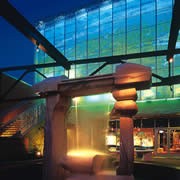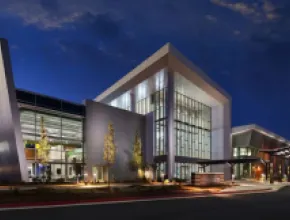North Carolina’s Triangle area, comprising Raleigh, Durham and Chapel Hill, is an intriguing, bold blend of good old Southern heritage and cutting-edge scientific development.
Best known as the home of Research Triangle Park, a 7,000-acre development in Durham that is devoted to a dozen different educational, technological and scientific disciplines, the area is also known for its history, from Raleigh’s state capitol building, chock full of stories about ghosts and secret spy rooms, to walking tours along the tree-lined campus of the University of North Carolina at Chapel Hill, the nation’s first state-supported college.
With a variety of new developments, the region is an inviting destination for groups heading to North Carolina.
Raleigh
Raleigh is in the midst of a $2 billion renaissance project aimed at transforming the capital city into a Southern urban gem for meetings and conventions.
With the new downtown Raleigh Convention Center coming online in spring 2008—featuring a total of 500,000 square feet of event space—along with new hotels, restaurants and public art projects, as well as museum improvements and the beautification of historic Fayetteville Street—the city is poised to maximize its potential as a premier group destination.
“Raleigh is a new option for planners,” says Dave Heinl, president and CEO of the Greater Raleigh CVB. “There’s a demand for state and regional meetings that have wanted to be here, and now we have the facilities coming in.”
The Raleigh Marriott City Center, opening in late 2008 with 400 rooms, 15 suites and nearly 15,000 square feet of meeting space will serve as the headquarters hotel for the new convention center, and less than a block away, the recently renovated, 355-room Sheraton Raleigh Hotel features 14,000 square feet of meeting space.
Other new hotels in Grater Raleigh include the 150-room Umstead Hotel and Spa, which debuted in Cary in January with more than 16,000 square feet of indoor meeting space, a restaurant, a full-service spa, and a sculpture garden; the Renaissance Raleigh North Hills, set to open this summer with 229 rooms and nearly 10,000 square feet of meeting space; and the Westin Raleigh, slated to open in spring 2009 near Crabtree Valley Mall with 290 rooms and 30,000 square feet of event space.
The new developments will augment the city’s existing lineup of meeting facilities, which include the RBC Center, a stadium with 700,000 square feet of event space, plus 50,000 square feet of meeting space, and the McKimmon Conference and Training Center, which features 37,000 square feet of meeting space.
Downtown, the North Carolina Museum of Art will unveil a $75 million expansion in 2008. Also downtown are the state museums for history and natural sciences, which are a short walk from the new convention center, hotels, restaurants, and nightlife.
“We’re a walkable city,” says Heinl. “And we have so much to offer, especially now. Raleigh is growing, and really coming alive.”
Interspersed with the new projects are historic draws, including Pullen Park, one of the city’s oldest parks, featuring train rides, paddleboats, a 1911 carousel, and the ultimate down-home icon, a statue of Andy and Opie from the Andy Griffith Show.
Another popular option is the guided tour of the state capitol, a Greek Revival structure reported to have a few ghostly residents. Strange noises and occurrences have been witnessed over the years by staff, and stories abound regarding secret rooms used by spies during the Civil War.
Durham
Durham is home to the famed Research Triangle Park, with 145 organizations, 39,000 employees and ongoing work in the fields of biotechnology, pharmaceuticals, telecommunications, microelectronics, public health, and much more. Add to that the institutions of Duke University and North Carolina Central University, and Durham has achieved a reputation as a diverse meetings destination, with literally something for everyone.
“Durham has a unique sense of place,” says Shelly Green, COO for the Durham CVB. “You’ll be able to find much more than just a ballroom here; we have some of the best chefs in the country, plus we can provide speakers from Research Triangle Park.”
With the brainpower of Research Triangle Park and the universities, it’s no surprise that this is a strong market for meetings in the medical, educational and technology fields. But Durham also does well with the religious and sports markets, thanks to the awe-inspiring Duke Memorial United Methodist Church, a Gothic Revival structure, along with Durham Bulls Athletic Park, home to the Durham Bulls baseball team, and Cameron Indoor Stadium at Duke University.
Cultural and natural activities abound at the recently expanded Museum of Life and Science. This spring, the museum will open Catch the Wind, a four-acre outdoor area that illustrates how wind affects the environment. The exhibit will include a sailboat pond and a Leonardo Da Vinci-inspired flying machine that visitors can actually climb inside.
A new cultural draw is planned for the city’s downtown area: the $44 million, 2,800-seat Durham Performing Arts Center, slated to open in mid-2008. The center will feature a pavilion area for receptions.
Meanwhile, the $24 million Nasher Museum of Art debuted at Duke in late 2005.
Several new hotels are also on the horizon, according to Green, who expects 900 new rooms to be completed in the next two years.
Included in that number are several new properties opening in mid- to late summer of this year: the 150-room Hilton Garden Inn; the 120-room Hotel Indigo; the 120-room Staybridge Suites, and a 100-room boutique hotel that has yet to be flagged.
Recent facility upgrades include the Washington Duke Inn and Golf Club, which expanded to 180 rooms and added a new 7,000-square-foot conference center. The Paul J. Rizzo Conference Center also completed a 60-room expansion in March 2006.
The city’s largest group venue is the Durham Civic Center Complex, with 103,000 square feet of event space, and other options include the 19,000-square-foot Charles Hamner Conference Center.
Chapel Hill/Orange County
Often called the “Southern Part of Heaven,” Chapel Hill and Orange County provide an irresistible mix of lush foliage, rolling hills, historic sites, and a thriving art community.
The area’s heritage ranges from pre-Revolutionary War cemeteries and Ayr Mount, a circa-1815 plantation home restored to its original glory, to the Morehead Planetarium and Science Center, where astronauts trained during the early days of NASA. Nearby in Hillsborough, the entire downtown district is listed on the National Register of Historic Places.
The University of North Carolina (UNC) was chartered in 1789 at Chapel Hill, and guided tours are available for visitors who want to explore the 200-year history of this 729-acre campus. Also on the grounds is the Ackland Art Museum, which has an impressive collection of European works.
“We host a lot of medical and educational meetings,” says Linda Ekeland, director of sales for the Chapel Hill/Orange County Visitors Bureau. “We’re spending more time on campus as well, focusing on a backyard marketing campaign.”
The destination’s main meeting venue is the William and Ida Friday Center for Continuing Education, with 25,000 square feet of function space and a 425-seat auditorium, and other group options include UNC’s Carolina Club and the Morehead Planetarium.
The Sheraton Chapel Hill and the Carolina Inn are among the meetings-friendly hotels in town, and two new properties opened in January: the Franklin Hotel, a 67-room boutique property with 2,300 square feet of meeting space; and the 108-suite Residence Inn by Marriott–Chapel Hill, catering to small meetings with 900 square feet of meeting space.
For More Info
Chapel Hill/Orange County Visitors Bureau 919.968.2060
www.chocvb.org
Durham CVB 919.687.0288
www.durham-nc.com
Greater Raleigh CVB 919.834.5900
www.visitraleigh.com






